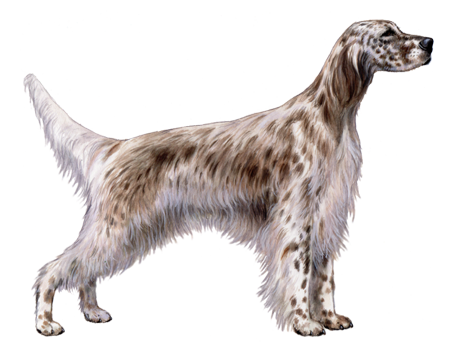
Murray River Retriever
A confident and energetic breed, the Murray River Retriever is skilled at flushing, retrieving, and tracking. But these loyal pups also make loving pets and are protective of their families.
Interested in discovering if your dog is a Murray River Retriever?
Check out Wisdom Panel's DNA tests.
Murray River Retriever Traits
General Appearance
Large dogs with a stocky build, Murray River Retrievers are longer than they are tall, with muscular legs and distinctive webbed feet.
Coat and Coloring
The Murray's liver-colored coat feels oily to the touch and is thick enough to protect against cold water. The curls on the coat range from tight curls to dense ringlets. These pups may also have feathering on the back of their forelegs.
Distinctive Physical Traits
Murrays have broad, flat skulls, chiseled muzzles, hazel eyes, and large drop ears covered in wavy hair.
Murray River Retriever Temperament
Murray River Retrievers are intelligent, determined hunters and good-natured family pets. Affectionate with their humans, they have an instinctively loyal and protective nature.
This breed is typically friendly with other dogs. But they may benefit from slow, intentional introductions to cats or other small pets.
Murray River Retriever History
The Murray River Retriever is the only gun dog developed in Australia. References to the breed date back to the mid-1800s, but its exact origins are unknown.
One popular theory is that Irishmen brought their Irish Water Spaniels to Australia when they emigrated in the wake of the potato famine. They then developed these dogs further to protect paddle steamers and retrieve downed ducks along the banks of the Murray River.
Though that's just one of several hypotheses, there's no question that the Murray River Retriever is closely associated with the river it's named after. Modern-day Murrays often work as search and rescue dogs, assistance dogs, and bomb detection dogs.
Currently, no official breed standard for the Murray exists. But the Murray River Retriever Association is in the process of petitioning the Australian National Kennel Council to recognize the breed.
Murray River Retriever Care
Nutrition
Murrays thrive on a high-quality diet formulated for their life stage (e.g., puppy, adult, senior). To help your dog maintain a healthy weight, measure their portions to avoid overfeeding and keep an eye on how many treats you're giving them. As a guideline, treats should make up no more than 10% of a dog's daily calories.
Grooming
Grooming a Murray River Retriever is relatively low maintenance. Regular brushing and the occasional trim on their ears, back of their legs, and feet will keep your pup looking their best.
The Murray's long ears may make the breed more prone to ear infections. To help prevent issues, check your dog's ears regularly and clean them as needed to remove wax build-up and debris. Nail trims should also be part of every dog's grooming routine. If nails grow too long, they can cause pain and potentially lead to problems running or walking.
Lastly, good dental hygiene is critical to your pup's overall health. Dental disease is one of the most common health conditions in adult dogs. Left untreated, it can contribute to other serious issues. In addition to professional cleanings, establish an at-home dental care program that includes regular teeth brushing and veterinarian-recommended dental chews.
Exercise
This sporty breed needs a moderate amount of daily exercise to stay happy and healthy. Backyard play sessions, long walks, and games of fetch are all great ways to keep them active. These dogs also enjoy splashing around in the water and showing off their natural swimming abilities.
Training
Murrays are intelligent, eager-to-please dogs. They respond well to strong leadership and positive, reward-based training.
Additionally, all dogs benefit from early socialization. Getting your pup comfortable with different people and environments at an early age will help them develop into a confident, well-mannered adult dog.
Breed Group
Sporting
The sporting group breeds are incredibly diverse in personality and appearance, but can be characterized as very sturdy. They were developed to work closely with people and in general have a very responsive nature and high intelligence.
Resources
https://janedogs.com/murray-river-retrievers/
https://www.mrr.org.au/choosingamurray
Reviewed July 9, 2021 by Annette Louviere, DVM





































































